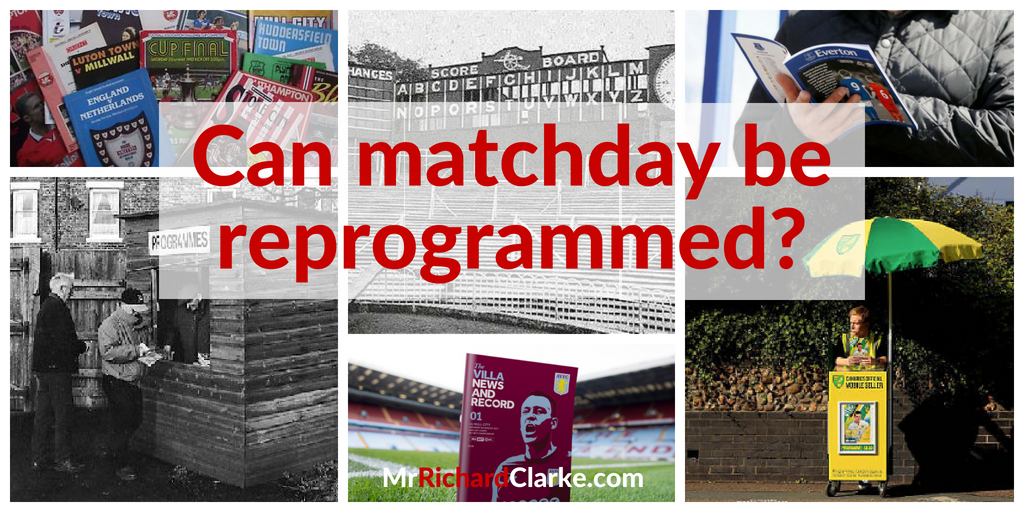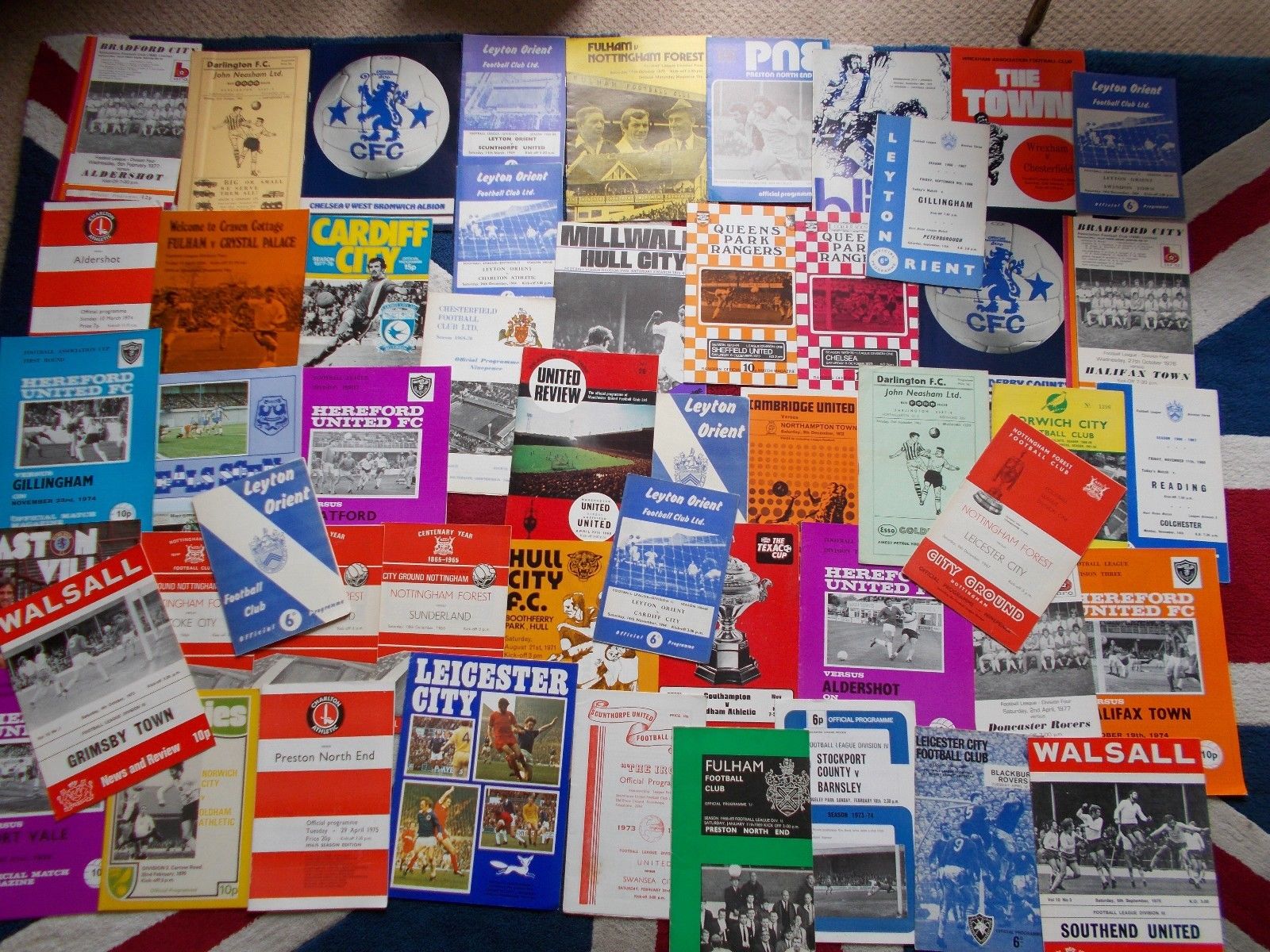Can matchday be reprogrammed?
When I was my son’s age, I read Tiger and Scorcher, the back pages of the Daily Express and the Arsenal programme.
That's it.
Yes, I would later cast my eyes over Shakespeare, Hardy and whatever other nonsense my English teacher compelled me to consume.
But those three were my sporting staples and, beyond the odd sci-fi novel, my main reading matter growing up.
The programme was essential at the game.
Firstly, it was reading matter to while away time pre-game and at half-time given that the only other entertainment was the dismal din of the tannoy music.
Then there was its contribution to matchday.
The back cover was the only place the team was printed. There were no names on shirts so if you missed the announcement of the changes then you might struggle to identify some of your own side let alone the opposition.
It also had the day’s other major games printed alongside a letter (eg A Burnley v Everton, B Chelsea v QPR). This was to help you understand the set up on the hoarding in one of the corners, a black and white board with the letters A to Z from left to right across the top. Underneath each were two slots. Periodically, a man in a white coat would slide in the scores. So if 0 and 1 were below the B then we all knew Rangers had taken a surprise lead at Stamford Bridge.
The scoreboard at Highbury
Of course, we don’t need the announcements of changes anymore as they are up on the big screen. Ditto the latest scores.
If the signal is good enough in the ground, we don’t even need a big screen given the sophistication of the small one in our pocket.
And, I am afraid, we do not need programmes any more.
Recently, the English Football League voted to change the regulation that mandated clubs to produce their own matchday publications. Clubs had been concerned about being forced to do something that took time and cost money.
It caused a minor ripple about those of us who care about these things.
And, believe me, I do.
These are not mine but they are the 1970s and 80s programmes I used to collect.
Like many football-mad little boys, I was a programme collector.
Like many football-sad big boys, sackfuls of the things still litter my loft.
And, of course, the Arsenal programme came under my watch for the latter half of my career at the club. (But I hasten to add, never under my editorship. Like Wenger with the George Graham Back Four, you let a quality team just do their thing.)
At the start of my relationship with them, programmes were a memory of a game, a symbol that I was there. But then the recollections became burdened by the sheer weight of games. In the end, clinging on to them was wrong, but so was letting them go.
That goes for the situation we are in now too.
Back then, programmes had a valuable role apart from mere matchday entertainment. For example, the news section of the Arsenal programme is called VOA, that stands for Voice of Arsenal.
It is a section that has been going for almost half-a-century and, until 15 years ago, it was THE mouthpiece of the club; the only way the club could get out its information entirely unmediated.
Club websites gradually usurped that role and now their social media accounts have literally adopt the language and tone of a fan to make the communication direct and resonant.
Now, they are the voice.
The EFL's stance on matchday programmes is news story. But do enough people care?
Decades ago, programmes also offered unique content. For example, those endlessly fascinating grids at the back that horizontally listed out the teams that had played in each match. You could not get those elsewhere. The same applied to the fixtures in the months ahead as papers tended to show a weekly schedule. Then there was youth and reserve team information.
All this is now better produced and more readily available elsewhere, not least on other club products.
Then there were the interviews and columns. Unfortunately, these had a tendency to be dipped in too much club vanilla. And, as we know, boring content will not last long these days. Similar content still exists on club websites, but they are not driving new audiences.
EFL's statement on the reasons for this summer's vote.
Over time, programmes had become too formulaic, too thin, too bland and too expensive. Meanwhile, the independent fanzines that started in the 1980s were a significant new voice and a solid challenge as the primary matchday publication. However, I always felt they were more of a complementary buy.
Still, as technology changed, fanzines were surpassed by blogs and then fan channels to such an extent that the relevance of the supporters’ magazine is now in question. It was both notable and sad that The Gooner, a venerable and well-produced Arsenal fanzine, was struggling for survival at the end of last season. In its day, it had been every bit as important as Arsenal Fan TV today.
Of course, all this says more about the medium rather than the content. And media has always been a technology business.
Fanzine articles and Fan TV videos have a similar tone and serve the same audience. Likewise programme and club website video interviews.
But in the age in which programmes were popular, the processing power of iPhone would have been housed in an entire room. The information in your pocket these days has eroded much of the USP of club publications so, with the cost of football going up it is the easiest expense to drop. No matter the quality of the product.
The expense of food and beverage at grounds also means many more fans socialise outside. Arriving later gives them less opportunity to buy a programme and less reason to do it.
Matchday publications do not have the same history in other countries. Many European clubs had to go to a special effort if they qualified for the Champions League as they were mandatory.
However, it is interesting that, in my recent footballing travels, the members of content teams at Seattle Sounders and Borneo FC have proudly shown me their new programmes. It is still considered something that proper football clubs 'should' do.
And make no mistake, I would love programmes to continue in their printed form. The tablets versions just do not seem like the real thing.
In my role as a consultant, I have discussed with clubs a free matchday-centric app based on the data acquisition. But this is dependent on fully functioning stadium wifi, a concerted effort from the club and demand. We tried standalone apps for the FA Cup 2014 and Wenger’s 1000th game. They were worthwhile experiments with inconclusive results.
That may change, we might have just been early. Certainly, the future of club content, like the future of most media, appears to be based on what works on your phone.
And it is also certain that the demand for programmes has declined, so has their significance. And that is where this issue has come from. Fans don’t want them enough so clubs lower down the league can’t afford them.
The market has spoken, now the traditionalists should listen.
Digital has changed almost everything and, despite its cultural significance, this is a minor casualty.
In my early days in charge of Arsenal.com when we were charged £4 a month for access to the videos, I was taken to task by certain Season Ticket holders who disliked forking out for “the web stuff” as they had paid the club enough.
Exasperated, I snapped back at one, saying “what was the response when you asked for a free programme, given that was club content too”.
I was wrong to do so but it was part of my pushback on the “web content = worthless = free” presumption in the early days.
He struggled to muster much of a reply.
I fear that, apart from glossy souvenirs at big clubs and big games, the much-loved institution of the club programme will not find a long-term answer too.
It feels inevitable but it is a shame nonetheless.








